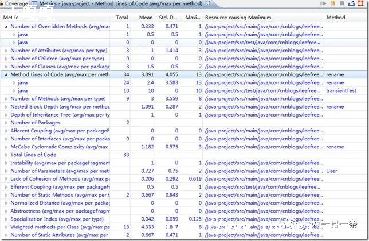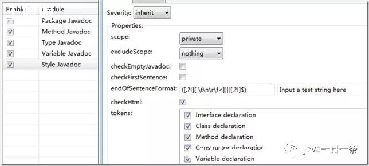

一. 高亮的内容:
需要高亮的内容有:
① 关键字, 如 public, int, true 等.

二. 实现高亮的核心方法:
StyledDocument.setCharacterAttributes(int offset, int length, AttributeSet s, boolean replace)
JTextArea使用的是PlainDocument, 此document不能进行多种格式的着色.
JTextPane, JEditorPane使用的是StyledDocument, 默认就可以使用.
四. 何时进行着色.
为了监视到文本的内容发生了变化, 要给document添加一个DocumentListener监听器, 在他的removeUpdate和insertUpdate中进行着色处理.
而changedUpdate方法在文本的属性例如前景色, 背景色, 字体等风格改变时才会被调用.
@Override
public void changedUpdate(DocumentEvent e) {

}
public void insertUpdate(DocumentEvent e) {
try {
colouring((StyledDocument) e.getDocument(), e.getOffset(), e.getLength());
} catch (BadLocationException e1) {
e1.printStackTrace();
public void removeUpdate(DocumentEvent e) {
// 因为删除后光标紧接着影响的单词两边, 所以长度就不需要了
colouring((StyledDocument) e.getDocument(), e.getOffset(), 0);
五. 着色范围:
pos: 指变化前光标的位置.
len: 指变化的字符数.
例如有关键字public, int
单词"publicint", 在"public"和"int"中插入一个空格后变成"public int", 一个单词变成了两个, 这时对"public" 和 "int"进行着色.
着色范围是public中p的位置和int中t的位置加1, 即是pos前面单词开始的下标和pos+len开始单词结束的下标. 所以上例中要着色的范围是"public int".
提供了方法indexOfWordStart来取得pos前单词开始的下标, 方法indexOfWordEnd来取得pos后单词结束的下标.
public int indexOfWordStart(Document doc, int pos) throws BadLocationException {
// 从pos开始向前找到第一个非单词字符.
for (; pos 0 isWordCharacter(doc, pos - 1); --pos);
return pos;
public int indexOfWordEnd(Document doc, int pos) throws BadLocationException {
for (; isWordCharacter(doc, pos); ++pos);
一个字符是单词的有效字符: 是字母, 数字, 下划线.
public boolean isWordCharacter(Document doc, int pos) throws BadLocationException {
char ch = getCharAt(doc, pos); // 取得在文档中pos位置处的字符
if (Character.isLetter(ch) || Character.isDigit(ch) || ch == '_') { return true; }
return false;
所以着色的范围是[start, end] :
int start = indexOfWordStart(doc, pos);
int end = indexOfWordEnd(doc, pos + len);
六. 关键字着色.
从着色范围的开始下标起进行判断, 如果是以字母开或者下划线开头, 则说明是单词, 那么先取得这个单词, 如果这个单词是关键字, 就进行关键字着色, 如果不是, 就进行普通的着色. 着色完这个单词后, 继续后面的着色处理. 已经着色过的字符, 就不再进行着色了.
public void colouring(StyledDocument doc, int pos, int len) throws BadLocationException {
// 取得插入或者删除后影响到的单词.
// 例如"public"在b后插入一个空格, 就变成了:"pub lic", 这时就有两个单词要处理:"pub"和"lic"
// 这时要取得的范围是pub中p前面的位置和lic中c后面的位置
char ch;
while (start end) {
ch = getCharAt(doc, start);
if (Character.isLetter(ch) || ch == '_') {
// 如果是以字母或者下划线开头, 说明是单词
// pos为处理后的最后一个下标
start = colouringWord(doc, start);
} else {
//SwingUtilities.invokeLater(new ColouringTask(doc, pos, wordEnd - pos, normalStyle));
++start;
public int colouringWord(StyledDocument doc, int pos) throws BadLocationException {
int wordEnd = indexOfWordEnd(doc, pos);
String word = doc.getText(pos, wordEnd - pos); // 要进行着色的单词
if (keywords.contains(word)) {
// 如果是关键字, 就进行关键字的着色, 否则使用普通的着色.
// 这里有一点要注意, 在insertUpdate和removeUpdate的方法调用的过程中, 不能修改doc的属性.
// 但我们又要达到能够修改doc的属性, 所以把此任务放到这个方法的外面去执行.
// 实现这一目的, 可以使用新线程, 但放到swing的事件队列里去处理更轻便一点.
SwingUtilities.invokeLater(new ColouringTask(doc, pos, wordEnd - pos, keywordStyle));
SwingUtilities.invokeLater(new ColouringTask(doc, pos, wordEnd - pos, normalStyle));
return wordEnd;
因为在insertUpdate和removeUpdate方法中不能修改document的属性, 所以着色的任务放到这两个方法外面, 所以使用了SwingUtilities.invokeLater来实现.
private class ColouringTask implements Runnable {
private StyledDocument doc;
private Style style;
private int pos;
private int len;
public ColouringTask(StyledDocument doc, int pos, int len, Style style) {
this.doc = doc;
this.pos = pos;
this.len = len;
this.style = style;
public void run() {
// 这里就是对字符进行着色
doc.setCharacterAttributes(pos, len, style, true);
} catch (Exception e) {}
七: 源码
关键字着色的完成代码如下, 可以直接编译运行. 对于数字, 运算符, 字符串等的着色处理在以后的教程中会继续进行详解.
import java.awt.Color;
import java.util.HashSet;
import java.util.Set;
import javax.swing.JFrame;
import javax.swing.JTextPane;
import javax.swing.SwingUtilities;
import javax.swing.event.DocumentEvent;
import javax.swing.event.DocumentListener;
import javax.swing.text.BadLocationException;
import javax.swing.text.Document;
import javax.swing.text.Style;
import javax.swing.text.StyleConstants;
import javax.swing.text.StyledDocument;
public class HighlightKeywordsDemo {
public static void main(String[] args) {
JFrame frame = new JFrame();
JTextPane editor = new JTextPane();
editor.getDocument().addDocumentListener(new SyntaxHighlighter(editor));
frame.getContentPane().add(editor);
frame.setDefaultCloseOperation(JFrame.EXIT_ON_CLOSE);
frame.setVisible(true);
/**
* 当文本输入区的有字符插入或者删除时, 进行高亮.
*
* 要进行语法高亮, 文本输入组件的document要是styled document才行. 所以不要用JTextArea. 可以使用JTextPane.
* @author Biao
*/
class SyntaxHighlighter implements DocumentListener {
private SetString keywords;
private Style keywordStyle;
private Style normalStyle;
public SyntaxHighlighter(JTextPane editor) {
// 准备着色使用的样式
keywordStyle = ((StyledDocument) editor.getDocument()).addStyle("Keyword_Style", null);
normalStyle = ((StyledDocument) editor.getDocument()).addStyle("Keyword_Style", null);
StyleConstants.setForeground(keywordStyle, Color.RED);
StyleConstants.setForeground(normalStyle, Color.BLACK);
// 准备关键字
keywords = new HashSetString();
keywords.add("public");
keywords.add("protected");
keywords.add("private");
keywords.add("float");
keywords.add("double");
SwingUtilities.invokeLater(new ColouringTask(doc, start, 1, normalStyle));
* 对单词进行着色, 并返回单词结束的下标.

* @param doc
* @param pos
* @return
* @throws BadLocationException
String word = doc.getText(pos, wordEnd - pos);
* 取得在文档中下标在pos处的字符.
* 如果pos为doc.getLength(), 返回的是一个文档的结束符, 不会抛出异常. 如果pos0, 则会抛出异常.
* 所以pos的有效值是[0, doc.getLength()]
public char getCharAt(Document doc, int pos) throws BadLocationException {
return doc.getText(pos, 1).charAt(0);
* 取得下标为pos时, 它所在的单词开始的下标. ?≡wor^d?≡ (^表示pos, ?≡表示开始或结束的下标)
* 取得下标为pos时, 它所在的单词结束的下标. ?≡wor^d?≡ (^表示pos, ?≡表示开始或结束的下标)
* 如果一个字符是字母, 数字, 下划线, 则返回true.
char ch = getCharAt(doc, pos);
* 完成着色任务
这个最好不要用Java做 (性能很差)如果不用PS的话 用C++来做图形修改吧
java是编程语言里比较难学的一门,如果有心从事编程方向的工作,最好到专业机构学习并有更多的项目实践,更贴近市场,这样更有利于将来的发展.
用递归还行内存没有溢出,实在不想10次循环.print实在不是可行的方法最好还是写文件速度比较快.
public class TestDffdsdf {
// TODO Auto-generated method stub
LinkedListString list=new? LinkedListString();
String[] a={"A","B","C","D"};
aaa(a,0,"",list);
for(String s:list)
System.out.println(s);
public static void aaa(String[] a,int i,String s,ListString list){? ? ?
if(i10){
for(int t=0;ta.length;t++)
aaa(a,i+1,s+a[t],list);
}else
list.add(s);? ? ?
扩展资料:
通过调用类(这些类实现了Java API)中的方法来访问资源系统,把源文件编译生成一种二进制中间码,存储在class文件中,然后再通过运行与操作系统平台环境相对应的Java虚拟机来运行class文件,执行编译产生的字节码,调用class文件中实现的方法来满足程序的Java API调用.
ChromHMM是基于ChIP-seq组蛋白数据检测染色质状态的工具.
基因组区域特定的组蛋白修饰或修饰的组合具有特定的功能.
特定标记的区域和作用:
获取上述标记区域的方式通常是call peak, 但是,理想的情况下需要获取多个组蛋白标记的整合结果.ChromHMM是一个基于HMM模型的用于检测染色质状态的java软件.
Chromatin states的定义基于组蛋白修饰的不同组合和对应的不同功能区域.
其目的是将基因组区分为具有生物学功能的区域或片段.
以下为染色质segment的案例:
第一段:如何使用ChromHMM
(1)使用环境: java
如果自己进行分析,还需要: 比对软件和bedtools
第二段:使用流程如下:
①.、测序获取reads
第三段:具体操作步骤
(1)? Alignment
? ? bedtools bamtobed -i sample.bam sample.bed
? ?其中,cellmark?letable.txt记录多个样本的修饰BED数据,例如:
? ?cell1 mark1 cell1_mark1.bed cell1_control.bed
ChromHMM的输出:
? ? 生成HTML报告?webpage_N.html (N是状态)
包含信息如下:
①? Model learned: transi-on? ?and? ?emission? ?parameters可视化segmentation:
Genome Browser: https ://genome.ucsc.edu/
IGV:? https ://
其他参考 :
①? Segway: https ://pmgenomics.ca/ho ?manlab/proj/segway/
想要了解更多有关Java开发的java代码染色相关咨询,推荐咨询千锋教育.千锋励精图治,不改教育初心.十一年来,千锋以政策为引导,不断完善国内特色现代职业教育体系建设,充分发挥教研师资队伍使命,构建品质教育,加大创新型人才培养力度,为经济发展提供智力人才和智力支撑,成为新时期职业教育发展的新方向,在同行业中有很高的美誉度.